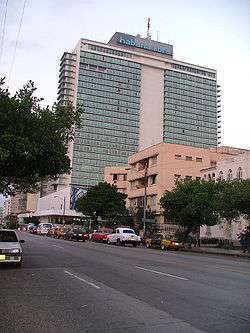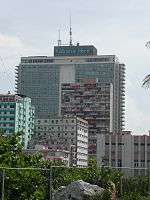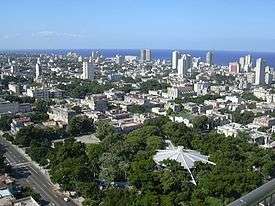Hotel Tryp Habana Libre
| Hotel Tryp Habana Libre | |
|---|---|
 Hotel Tryp Habana Libre. The three balconies which are not glassed in on the left, near the top of the building, are part of the historic Castellana Suite. | |
| Hotel chain | Tryp Hotels |
| General information | |
| Location | Havana, Cuba |
| Address | Calle L e/ 23 y 25, Vedado |
| Opening | March 19, 1958 |
| Owner | Gran Caribe Hotels |
| Management | Meliá Hotels International |
| Technical details | |
| Floor count | 25 |
| Design and construction | |
| Architect | Welton Becket |
| Other information | |
| Number of rooms | 572 |
| Number of restaurants | 4 |
Hotel Tryp Habana Libre is one of the larger hotels in Cuba, situated in Vedado, Havana. The hotel has 572 rooms[1] in a 25-floor tower at Calle 23 ("La Rampa") and Calle L.
History
The hotel was built as the Habana Hilton, at a cost of $24 million, under the personal auspices of President Fulgencio Batista. It was constructed as an investment by the Caja de Retiro y Asistencia Social de los Trabajadores Gastronomicos,[2] the pension plan of the Cuban catering workers' union, with additional financing from the Banco de Fomento Agricola e Industrial de Cuba (BANFAIC). It was operated by the American Hilton Hotels International group and was designed by the well-known Los Angeles architect Welton Becket, who had previously designed the Beverly Hilton for the chain. Becket designed the 27-story Habana Hilton in collaboration with the Havana-based architects Lin Arroyo[3] and Gabriela Menéndez.[4] Arroyo was the Minister of Public Works under Batista.[5] The hotel was constructed by the Frederick Snare Corporation.[6]
The Habana Hilton opened with five days of festivities, from March 19-23, 1958,[7] with Conrad Hilton himself in attendance, accompanied by his companion, actress Ann Miller.[8] Hilton was joined by 300 invited guests, including socialite Virginia Warren, daughter of Chief Justice Earl Warren;[9] renowned Hollywood columnist Hedda Hopper, actress Terry Moore,[10] married radio hosts Tex McCrary and Jinx Falkenburg, actress Linda Cristal, dancer Vera-Ellen, actor Don Murray, actress Dolores Hart, ABC network President Leonard Goldenson, and journalist Leonard Lyons.[11] A formal blessing ceremony was held in the hotel's lobby on March 22, 1958, attended by Cuba's First Lady, Marta Fernandez de Batista; Francisco Aguirre, head of the catering workers' union; José Suárez Rivas, Minister of Labor; and other dignitaries. The ceremony was followed by a luncheon, with speeches by Hilton and Aguirre, and a huge gala dinner and ball in the hotel's grand ballroom.[12]
The Habana Hilton was Latin America's tallest and largest hotel. It boasted 630 guest rooms, including 42 suites; an elegant casino; six restaurants and bars, including a Trader Vic's and a rooftop bar; a huge supper club; extensive convention facilities; a shopping arcade; an outdoor pool surrounded by cabanas; and two underground garages with a capacity of 500 cars. The hotel also featured artwork commissioned from some of the most important Cuban modern artists of the day, including an enormous mosaic mural by Amelia Peláez over the main entrance and a tiled wall mural by René Portocarrero in the second-floor Antilles Bar overlooking the pool terrace.
The casino in the hotel was leased for $1 million a year to a group consisting of Roberto "Chiri" Mendoza, his brother Mario Mendoza, Clifford "Big Juice" Jones, Kenneth F. Johnson, and Sidney Orseck. Roberto Mendoza was a wealthy Cuban contractor and sugar planter who was a business associate of President Batista; Mario Mendoza was a lawyer; Orseck was an attorney from New York; Johnson was a senator in the Nevada state legislature and Jones was a former lieutenant governor of Nevada who had ownership interests in a number of Las Vegas casinos. Hilton officials said that 13 groups tried to lease the casino and 12 were "turned down because they either had underworld connections or had refused to subject themselves to rigid investigation." Speculation surfaced that the murder of Gambino crime family boss Albert Anastasia in October 1957 was tied to his interest in securing an ownership stake in the Hilton's casino. Roberto Mendoza and Santo Trafficante Jr., who had substantial gambling interests in Cuba, were both in New York at the time of Ananstasia's murder. The police investigation of the murder focused on this theory for a while but later looked at other theories. The murder was never solved.[13][14][15]
Following Fidel Castro's entry into Havana on January 8, 1959, the hotel became his headquarters,[16] with Castro residing for three months in the hotel's Continental Suite, room 2324.[17] The casinos throughout the city were briefly closed, but protests by Havana casino workers led to their reopening in February. Castro gave his first press conference in the hotel's ballroom on January 19, 1959[18] and soon took to giving regular interviews to international journalists in the hotel, famously declaring in the lobby that "If the Americans don’t like what is happening in Cuba, they can land the Marines, and then there will be 200,000 gringos dead."[19]
In October 1959, the Habana Hilton hosted the week-long American Society of Travel Agents annual international convention,[20] which had been scheduled before the Revolution. Castro and other officials attempted to present an image of Cuba as a continued tropical paradise for American tourists, as the country desperately needed the revenue, but growing anti-American political rhetoric was already having an impact on bookings at the increasingly empty hotel.[21] On New Year's Eve 1959/1960, Castro hosted an elaborate party in the Pavilion ballroom atop the hotel, designed to promote Cuba to Americans. The party was attended by numerous American journalists[22] and celebrities, including boxer Joe Louis, who had been hired by a PR firm to encourage black Americans to visit the island.[23] The efforts proved unsuccessful, and the Hilton's American operators struggled to keep the hotel open. Hilton International was forbidden under Cuban labor laws from firing any of the hotel's 670 employees, though the Hilton seldom had more than 100 guests. The Revolutionary government was eventually compelled to pay 2 million pesos to cover the hotel's operating expenses, and keep its employees working.[24]
The hotel remained in operation as a Hilton while relations between the US and Cuba worsened, until Jun 11, 1960, when the Cuban government nationalized the property. On June 15, 1960, Castro announced in a speech to the Restaurant and Hotel Workers Federation that he was renaming the hotel the Hotel Habana Libre (Hotel Free Havana).[25] The first Soviet embassy in Havana was soon temporarily established on two floors of the hotel.[26]
In 1964, Soviet female cosmonaut Valentina Tereshkova, the first woman in space, gave a press conference at the hotel.[27] From January 3-12, 1966, the Habana Libre hosted the first Tricontinental Conference[28] of Asian, African and Latin-American peoples.[29] Fidel Castro stayed in the hotel's Castellana Suite, room 2224, during the conference, and made the suite his home thereafter for all major diplomatic events. The suite is now kept as a museum, with all the original furniture and artwork from 1958. From October 23-November 20, 1966, the Habana Libre hosted the 17th Chess Olympiad, with guests including Bobby Fischer and Boris Spassky.[30] In 1967, the hotel hosted Marxist Chilean politician Salvador Allende.[31]
Following the collapse of the Soviet Union, the Cuban government focused on rebuilding the tourism industry. In 1993, they brought in the Spanish Guitart Hotels chain to manage the property as the Hotel Habana Libre Guitart.[32] Then, in 1996 the Spanish Sol Meliá chain assumed management of the hotel from Guitart. It was placed in their Tryp division of urban hotels and renamed Hotel Tryp Habana Libre. The hotel was extensively renovated between 1996 and 1997. Much of the interior was gutted and modernized. The guest rooms were remodeled, with the balconies all glassed in, except those of the historic Castellana Suite. The supper club on the second floor was converted to a buffet restaurant. Among the highlights of the work was the restoration of the huge Peláez mural on the exterior, which had spent decades hidden from public view. The hotel reopened on December 22, 1997,[33] with a speech by Eusebio Leal, who has spearheaded the restoration and conservation of the historic district of Old Havana.
In January 1998, the hotel served as the international media headquarters for the Papal visit to Cuba by Pope John Paul II.[34] Journalists including Peter Jennings, Dan Rather, Ted Koppel, Tom Brokaw and Christiane Amanpour reported from and were housed at the hotel.[35] CNN's Ted Turner and his wife, actress Jane Fonda, also visited the hotel at the time.[36]
On February 4, 2013, French daredevil Alain Robert, known as The French Spider-Man, climbed the hotel without ropes or a safety net, as is his custom, watched by hundreds of onlookers.[37]
Gallery
- Hotel Tryp Habana Libre
 Hotel Tryp Habana Libre
Hotel Tryp Habana Libre Hotel Tryp Habana Libre
Hotel Tryp Habana Libre_-_panoramio.jpg) Hotel Tryp Habana Libre
Hotel Tryp Habana Libre- Hotel Tryp Habana Libre - lobby
 Hotel Tryp Habana Libre seen from the Parque Coppelia
Hotel Tryp Habana Libre seen from the Parque Coppelia- The restored mural by Amelia Peláez is visible above the main entrance
 Hotel Tryp Habana Libre
Hotel Tryp Habana Libre- Hotel Tryp Habana Libre
_seen_from_Avenue_Carlos_Manuel_C%C3%A9spedes_-_panoramio.jpg) Top portion of the hotel
Top portion of the hotel Hotel Habana Libre, 1973
Hotel Habana Libre, 1973 Hotel Habana Libre, 1974
Hotel Habana Libre, 1974 Calle L, in front of the main entrance of Hotel Tryp Habana Libre
Calle L, in front of the main entrance of Hotel Tryp Habana Libre Havana public bus passing the Amelia Peláez mural
Havana public bus passing the Amelia Peláez mural Amelia Peláez mural over the main entrance
Amelia Peláez mural over the main entrance- Main entrance with Amelia Peláez mural
 View of the Vedado district from the hotel
View of the Vedado district from the hotel
References
- ↑ http://www.meliacuba.com/cuba-hotels/hotel-tryp-habanalibre
- ↑ https://www.emporis.com/companies/168351/caja-de-retiro-y-asistencia-social-de-los-trabajadores-gastronomicos-havana-cuba
- ↑ http://havanajournal.com/culture/entry/havana-architect-lin-arroyo-dead-at-90/
- ↑ "Archived copy". Archived from the original on 2013-12-27. Retrieved 2013-09-12.
- ↑ http://www.kcet.org/arts/artbound/counties/los-angeles/a-california-architect-visits-cuba.html
- ↑ http://www.hotelhabanalibre.com/en/architects,-builders.html
- ↑ https://digital.wolfsonian.org/WOLF045818/00001
- ↑ Memento for Junketeers The Billboard March 31, 1958 via books.google.com
- ↑ Socialite Virginia Warren Daly, 80, Dies Washington Post March 4, 2009
- ↑ Pleasure Island: Tourism and Temptation in Cuba by Rosalie Schwartz via books.google.com
- ↑ Memento for Junketeers The Billboard March 31, 1958 via books.google.com
- ↑ https://digital.wolfsonian.org/WOLF045818/00001/5j
- ↑ Gambling In Cuba Tied To U.S. Gangs: Hotel Executives Queried by Hogan in Investigation of Anastasia Murder New York Times January 9, 1958
- ↑ Pleasure Island: Tourism and Temptation in Cuba By Rosalie Schwartz
- ↑ Gangsterismo: The United States, Cuba and the Mafia, 1933 to 1966 By Jack Colhoun
- ↑ "Archived copy". Archived from the original on 2012-02-23. Retrieved 2016-11-30.
- ↑ http://paris1972-versailles2003.com/2011/04/22/habana-hilton-or-libre-and-yara-or-radiocentro/
- ↑ http://www.hotelhabanalibre.com/en/time-line.html
- ↑ The Habana Libre hotel, pawn in Castro's battle against the US The Guardian May 12, 2015
- ↑ How to lose tourists Sports Illustrated November 9, 1959
- ↑ How to lose tourists Sports Illustrated November 9, 1959
- ↑ http://cubajournal.co/heres-why-fidel-castro-was-the-first-media-revolutionary/
- ↑ http://www.tampabay.com/features/humaninterest/from-the-archives-ringing-in-the-new-year-with-fidel-castro-january-1960/2275061
- ↑ http://www.hotelhabanalibre.com/en/history.html
- ↑ http://lanic.utexas.edu/project/castro/db/1960/19600616.html
- ↑ The Habana Libre hotel, pawn in Castro's battle against the US The Guardian May 12, 2015
- ↑ https://www.facebook.com/TrypHabanaLibreCuba/photos/a.157565607592215.35636.144934855521957/1530555706959858/?type=3&theater
- ↑ http://www.latinamericanstudies.org/terrorism/tricontinental-01.htm
- ↑ http://www.hotelhabanalibre.com/en/time-line.html
- ↑ https://kevinspraggettonchess.wordpress.com/2009/11/02/havana-1966-chess-piecesboard-and-table/
- ↑ http://www.hotelhabanalibre.com/en/famous-guests.html
- ↑ Havana: Two Faces of the Antillean Metropolis by Joseph L. Scarpaci via books.google.com
- ↑ http://www.hotelhabanalibre.com/en/time-line.html
- ↑ http://www.christusrex.org/www2/fcf/papalvisit12098.html
- ↑ https://mobile.nytimes.com/1998/01/21/world/with-pope-due-the-cubans-wrest-dollars-from-heaven.html
- ↑ http://numerocinqmagazine.com/2011/05/18/what-its-like-living-here-stanley-fogels-cuba/
- ↑ http://www.mercurynews.com/2013/02/05/daredevil-alain-robert-climbs-cubas-former-havana-hilton/
External links
| Wikimedia Commons has media related to Hotel Havana Libre. |
- Sol Meliá Cuba - Habana Libre - Sol Meliá Cuba official website
- Sol Meliá - Habana Libre - Sol Meliá International official web site
- Hotel Habana Libre.com - hotel fansite
- Havana Hilton under construction, 1958 on YouTube
Coordinates: 23°08′21″N 82°22′58″W / 23.13917°N 82.38278°W